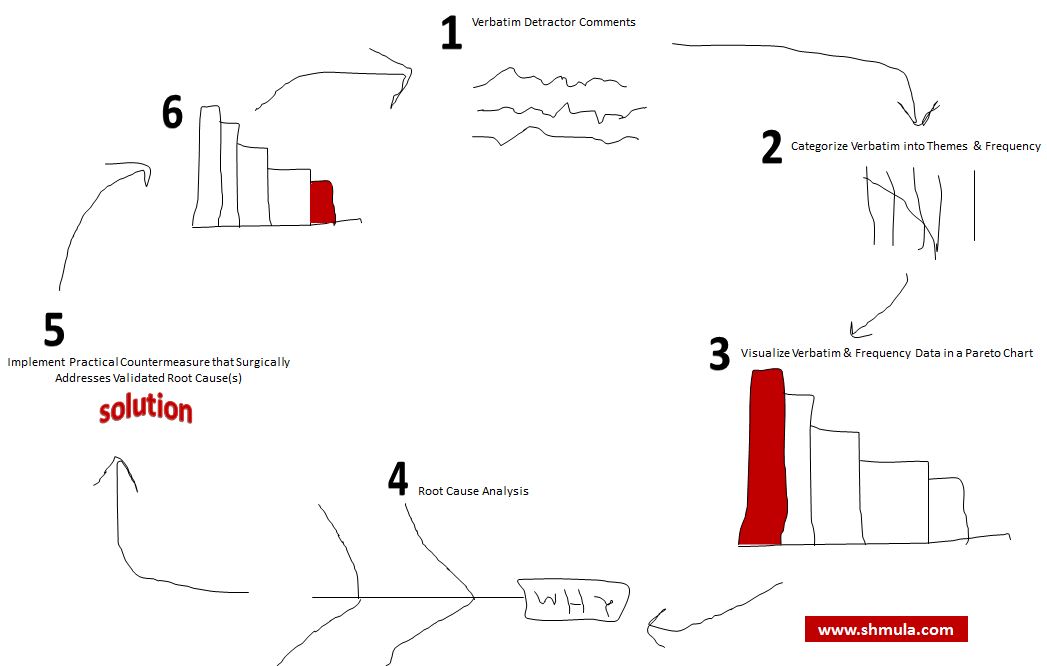The Net Promoter Score (NPS) is a metric that more and more companies are using as a measure of loyalty and, proponents argue, is a leading indicator of future profit and earnings. One of the critical components that many companies miss and fail to implement is the closed-loop customer feedback system that makes customer insights into actionable improvements.
In what follows, I’ll share my experience of how I’ve been able to blend Lean Thinking (or just plain continuous improvement) with NPS.
Customer Feedback Loop
Below is the high level Customer Closed-loop Feedback System I’ve designed and used at several companies:
If you’re loving this article, share it on Twitter by clicking here

If you’re looking at it and wondering to yourself “Hmmm, man, that looks a lot like the Toyota A3 approach or PDCA“, then you’d be right. That’s exactly what that is, with a few minor changes that I’ll describe below.
Step 1: Collect Customer Verbatim Comments
 This is the step where verbatim comments from Detractors, Promoters, and Neutral survey respondents are collected. In this step, we’re primarily interested in the Detractor verbatim comments.
This is the step where verbatim comments from Detractors, Promoters, and Neutral survey respondents are collected. In this step, we’re primarily interested in the Detractor verbatim comments.
Step 2: Categorize Verbatim Comments into Themes & Frequency

In this step, we need to satisfy the MECE Principle: Mutually Exclusive and Comprehensively Exhaustive. This means that if I tick x in one category, I cannot also tick x into another category.
Step 3: Visualize Data in a Pareto Chart

To make sense of the data, it must point us somewhere that is both directionally correct and actionable. One effective way to do that is to visualize the data in a Pareto Chart. Using the Pareto Principle, we hope to find the 80/20, in order to better align and mobilize our scarce resources as well as attack the 20% of the problems affecting 80% of our customers.
Step 4: Apply Root Cause Analysis

Once our Pareto is reasonably sufficient, we must then attack the first few bars in that Pareto. The next step is to do the 5 Whys or a more thorough root cause analysis. This step might even include Hypothesis Testing, if necessary in order to validate or invalidate our hypothesis.
Step 5: Implement Practical and Simple Countermeasures

Once hypotheses have been validated, then it’s important that we implement simple and effective countermeasures. This step must be done quickly and not get caught up in red tape or corporate bureacracy or else the defect will continue to negatively impact the customer, of which internal strife and internal infighting will be the cause. Get it done quickly, but apply effective and simple countermeasures that surgically attack the root cause(s).
Step 6: Measure and Adjust
 In order to learn and to improve, we must measure our efforts in order to gauge whether we actually improved the customer experience by reducing the defects they have shared with us. Ideally in this step, if we did things correctly, by effectively attacking the largest bar in the Pareto in a previous step, that bar which was the largest representation of a customer complaint should now be the smallest. This would represent success on behalf of the customer.
In order to learn and to improve, we must measure our efforts in order to gauge whether we actually improved the customer experience by reducing the defects they have shared with us. Ideally in this step, if we did things correctly, by effectively attacking the largest bar in the Pareto in a previous step, that bar which was the largest representation of a customer complaint should now be the smallest. This would represent success on behalf of the customer.
NPS Customer Feedback Loop, Closed Loop System, and Lean Thinking is a post from: Lean Six Sigma Consulting
